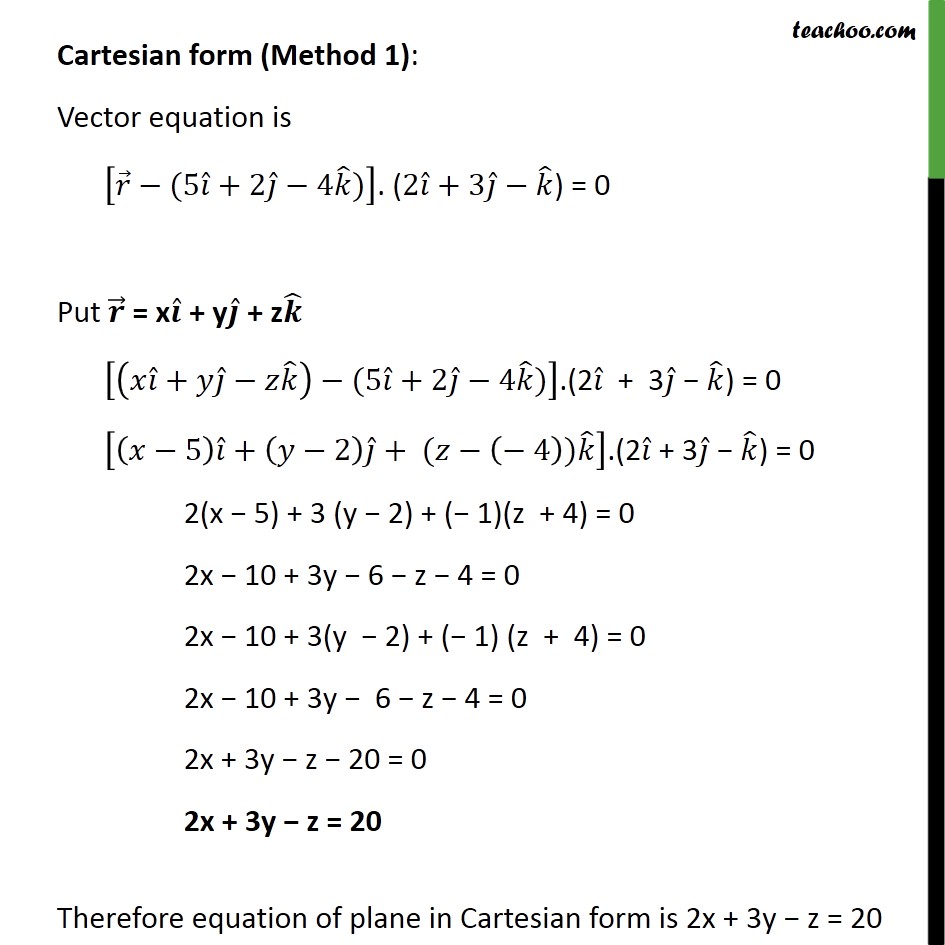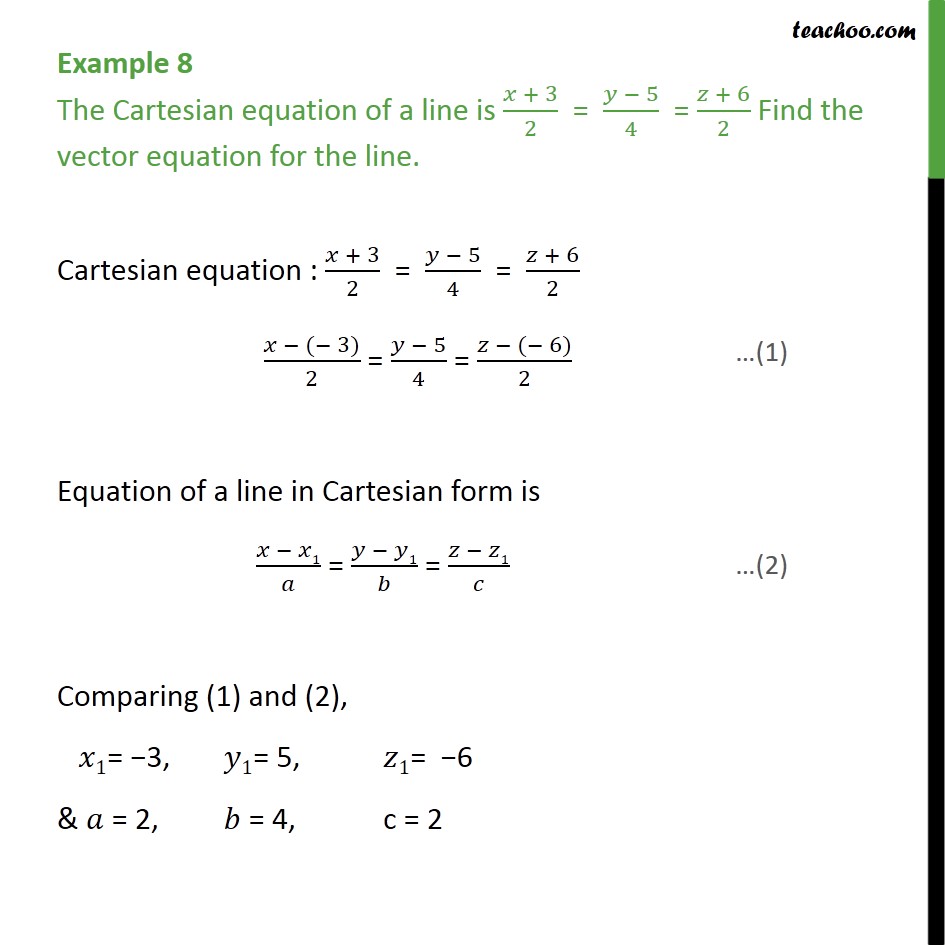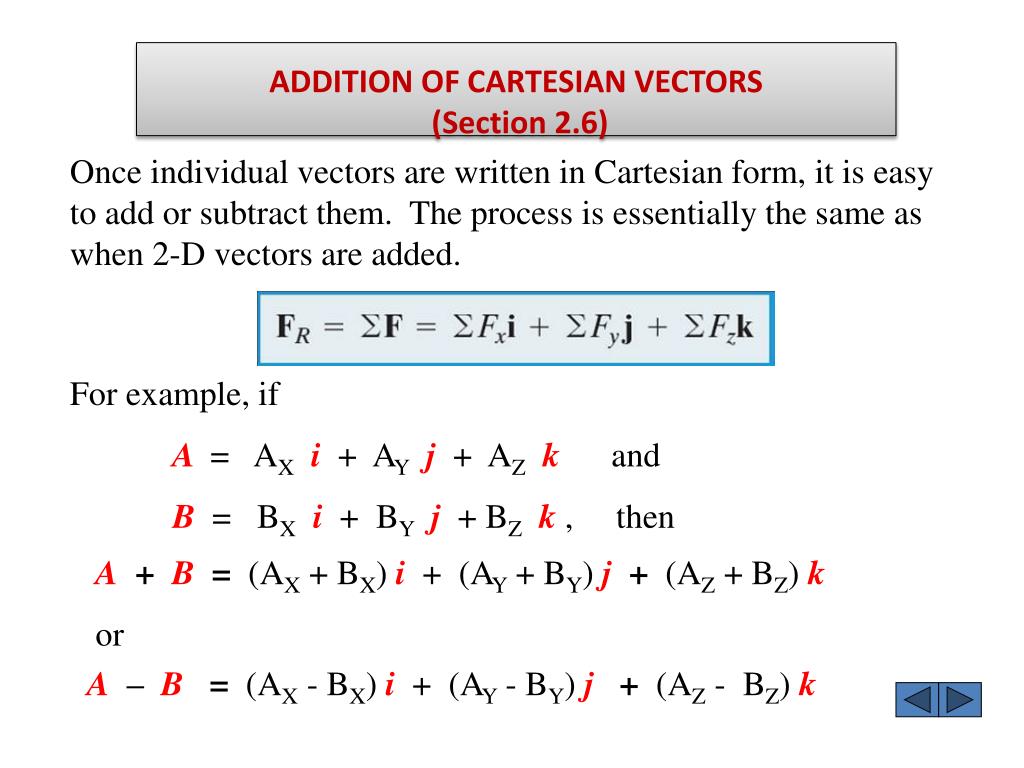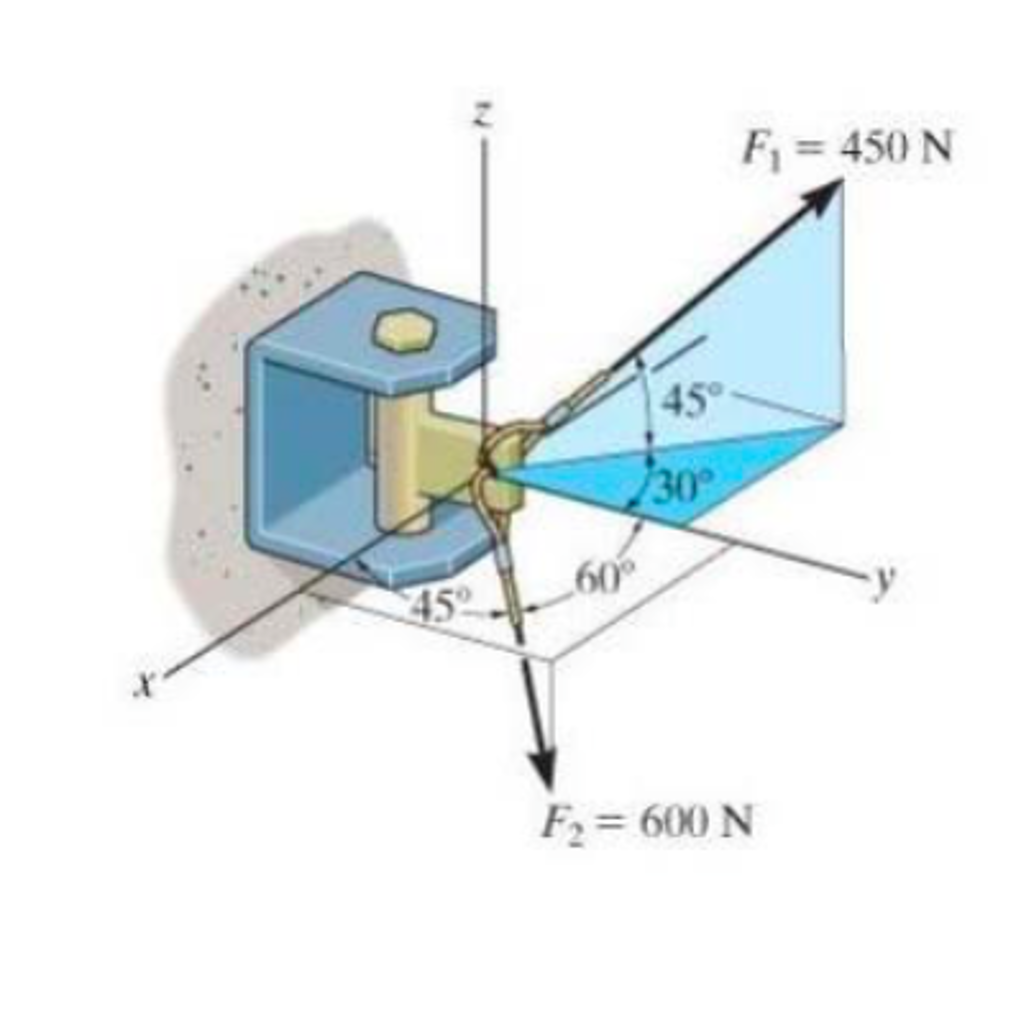Cartesian Form Vector
Cartesian Form Vector - A function (or relation) written using ( x, y ) or ( x, y, z ) coordinates. It’s important to know how we can express these forces in cartesian vector form as it helps us solve three dimensional problems. Then write the position vector of the point through which the line is passing. Show that the vectors and have the same magnitude. First find two vectors in the plane: Write the direction vector, b = a + b + c write the vector form of the equation as r = a + λ b. Web any vector may be expressed in cartesian components, by using unit vectors in the directions ofthe coordinate axes. Web there are usually three ways a force is shown. Find u→ in cartesian form if u→ is a vector in the first quadrant, ∣u→∣=8 and the direction of u→ is 75° in standard position. In this way, following the parallelogram rule for vector addition, each vector on a cartesian plane can be expressed as the vector sum of its vector components:
First, the arbitrary form of vector [math processing error] r → is written as [math processing error] r → = x i ^ + y j ^ + z k ^. The vector equation of a line is \vec {r} = 3\hat {i} + 2\hat {j} + \hat {k} + \lambda ( \hat {i} + 9\hat {j} + 7\hat {k}) r = 3i^+ 2j ^+ k^ + λ(i^+9j ^ + 7k^), where \lambda λ is a parameter. Here is what i have tried: Web converting vector form into cartesian form and vice versa. A = x 1 + y 1 + z 1; Web this is just a few minutes of a complete course. The plane containing a, b, c. Web there are usually three ways a force is shown. Web any vector may be expressed in cartesian components, by using unit vectors in the directions ofthe coordinate axes. A function (or relation) written using ( x, y ) or ( x, y, z ) coordinates.
Find u→ in cartesian form if u→ is a vector in the first quadrant, ∣u→∣=8 and the direction of u→ is 75° in standard position. Web there are usually three ways a force is shown. For example, using the convention below, the matrix. The following video goes through each example to show you how you can express each force in cartesian vector form. Web the cartesian form can be easily transformed into vector form, and the same vector form can be transformed back to cartesian form. (i) using the arbitrary form of vector Web the cartesian form of a plane can be represented as ax + by + cz = d where a, b, and c are direction cosines that are normal to the plane and d is the distance from the origin to the plane. The vector equation of a line is \vec {r} = 3\hat {i} + 2\hat {j} + \hat {k} + \lambda ( \hat {i} + 9\hat {j} + 7\hat {k}) r = 3i^+ 2j ^+ k^ + λ(i^+9j ^ + 7k^), where \lambda λ is a parameter. Round each of the coordinates to one decimal place. Magnitude & direction form of vectors.
Example 17 Find vector cartesian equations of plane passing Exampl
Adding vectors in magnitude & direction form. First, the arbitrary form of vector [math processing error] r → is written as [math processing error] r → = x i ^ + y j ^ + z k ^. A vector decomposed (resolved) into its rectangular components can be expressed by using two possible notations namely the scalar notation (scalar components).
Bab2
Vector line to cartesian form. For example, using the convention below, the matrix. Web cartesian coordinates in the introduction to vectors, we discussed vectors without reference to any coordinate system. In this way, following the parallelogram rule for vector addition, each vector on a cartesian plane can be expressed as the vector sum of its vector components: A function (or.
Example 8 The Cartesian equation of a line is. Find vector
Terms and formulas from algebra i to calculus. Web any vector may be expressed in cartesian components, by using unit vectors in the directions ofthe coordinate axes. For example, using the convention below, the matrix. In cartesian form, a vector a is represented as a = a x i + a y j + a z k. First, the arbitrary.
Express each in Cartesian Vector form and find the resultant force
Vector line to cartesian form. It’s important to know how we can express these forces in cartesian vector form as it helps us solve three dimensional problems. Then write the position vector of the point through which the line is passing. By working with just the geometric definition of the magnitude and direction of vectors, we were able to define.
PPT FORCE VECTORS, VECTOR OPERATIONS & ADDITION OF FORCES 2D & 3D
Web the cartesian form of a plane can be represented as ax + by + cz = d where a, b, and c are direction cosines that are normal to the plane and d is the distance from the origin to the plane. In this way, following the parallelogram rule for vector addition, each vector on a cartesian plane can.
Resultant Vector In Cartesian Form RESTULS
In this way, following the parallelogram rule for vector addition, each vector on a cartesian plane can be expressed as the vector sum of its vector components: How do i find the a, b, c, s, e, f, g, t, h, i, j a, b, c, s, e, f, g,. Web the cartesian form can be easily transformed into vector.
Express F in Cartesian Vector form YouTube
(i) using the arbitrary form of vector The vector equation of a line is \vec {r} = 3\hat {i} + 2\hat {j} + \hat {k} + \lambda ( \hat {i} + 9\hat {j} + 7\hat {k}) r = 3i^+ 2j ^+ k^ + λ(i^+9j ^ + 7k^), where \lambda λ is a parameter. A function (or relation) written using (.
Ex 11.2, 5 Find equation of line in vector, cartesian form
The plane containing a, b, c. Finding three points on the plane by setting two variables equal to 0: Show that the vectors and have the same magnitude. Web converting vector form into cartesian form and vice versa. The vector form can be easily converted into cartesian form by 2 simple methods.
Solved 1. Write both the force vectors in Cartesian form.
Cartesian coordinates, polar coordinates, parametric equations. Vector line to cartesian form. Web this is just a few minutes of a complete course. Round each of the coordinates to one decimal place. A function (or relation) written using ( x, y ) or ( x, y, z ) coordinates.
Find the Cartesian Vector form of the three forces on the sign and the
Web write given the cartesian equation in standard form. How do i find the a, b, c, s, e, f, g, t, h, i, j a, b, c, s, e, f, g,. Adding vectors in magnitude & direction form. Web converting vector form into cartesian form and vice versa. In this unit we describe these unit vectors in two dimensions.
In Cartesian Form, A Vector A Is Represented As A = A X I + A Y J + A Z K.
Find u→ in cartesian form if u→ is a vector in the first quadrant, ∣u→∣=8 and the direction of u→ is 75° in standard position. Web viewed 16k times. Web converting vector form into cartesian form and vice versa. Web explain the meaning of the unit vectors i,jandk express two dimensional and three dimensional vectors in cartesian form find the modulus of a vector expressed incartesian form find a ‘position vector’ 17 % your solution −→ oa= −−→ ob= answer −→ oa=a= 3i+ 5j, −−→ ob=b= 7i+ 8j −→
(I) Using The Arbitrary Form Of Vector
For example, using the convention below, the matrix. I prefer the ( 1, − 2, − 2), ( 1, 1, 0) notation to the i, j, k notation. Vector line to cartesian form. Magnitude & direction form of vectors.
The Plane Containing A, B, C.
Finding three points on the plane by setting two variables equal to 0: Web solution conversion of cartesian to vector : Write the direction vector, b = a + b + c write the vector form of the equation as r = a + λ b. Web i need to convert a plane's equation from cartesian form to parametric form.
In This Way, Following The Parallelogram Rule For Vector Addition, Each Vector On A Cartesian Plane Can Be Expressed As The Vector Sum Of Its Vector Components:
(a, b, c) + s (e, f, g) + t (h, i, j) so basically, my question is: A b → = 1 i − 2 j − 2 k a c → = 1 i + 1 j. Where λ ∈ r, and is a scalar/parameter Get full lessons & more subjects at:









